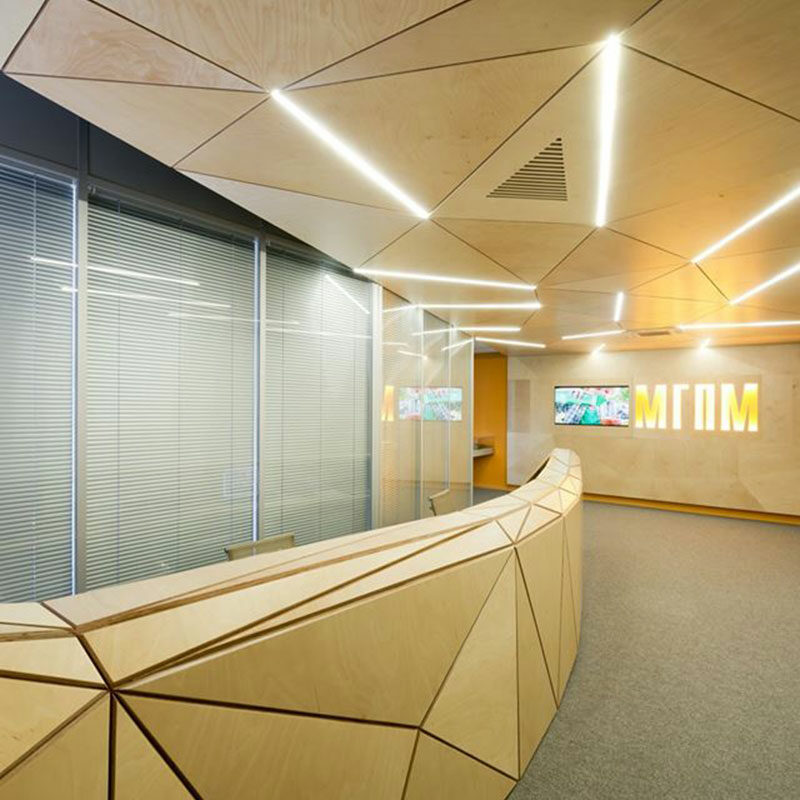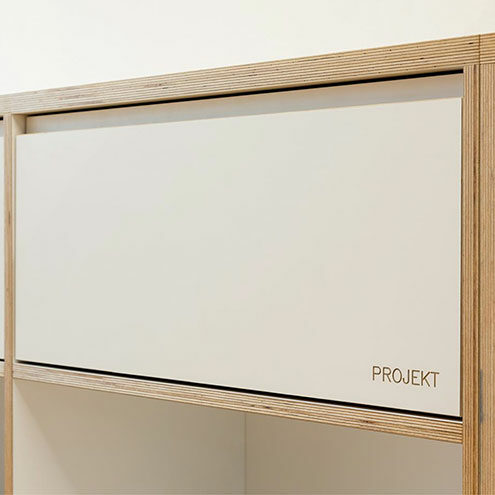Thermally fused melamine (TFM) is made by fusing a resin-impregnated sheet of décor paper directly to a substrate. There is no kraft paper used in TFM, and the resulting panel is ready for finishing. The décor paper generally weighs between 60 and 130 g/m2 and is the same as the paper used in the production of HPL, making for easy matching across materials. Heat and pressure activate the resin in the saturated TFM sheet, creating a cross-linked bond with the substrate. This effectively seals the substrate. Particleboard and MDF are ideal substrates for TFM because they are consistent, uniform in strength and free of defects.
TFM decorative panels can be manufactured with enhanced visual and performance characteristics. Surface textures are created with steel press plates that emboss the decorative overlay to heighten the realism of wood grain, stone or abstract designs. Steel press plates can also be used to create or control the gloss level of the surface. TFM decorative panels have excellent scratch and wear resistance. TFM decorative panels typically require a decorative edge treatment and can be specified with or without edge, and with single or opposite-side face treatments. Due to the performance, design flexibility and cost advantages, TFM offers an excellent option for designers and specifiers.
Common Uses
- Office Furniture
- Store Fixtures
- Closets
- Cabinets
- Commercial
- Hospitality
- Healthcare
- Shelving
The most common thermoset resin system used in TFM decorative panels is Melamine. The resin is introduced into the paper during an impregnating operation. After the paper is impregnated it is partially cured (B stage) using curing ovens. The melamine resin is fully cured under heat and pressure during hot press lamination. The B staged paper has a definite shelf life that varies with temperature and humidity. Melamine resins are fully cured at 300-400 psi and 300-400ºF. They are noted for their hardness, scratch resistance and colour stability and are the most commonly used resin in saturated paper overlays.
Flakeboard Melamine
The Flakeboard melamine collection includes nearly 100 of the most contemporary solid colours, prints and woodgrains. Along with popular classics and favourites, this collection promises distinctive looks that will endure and inspire. The TFM of choice is available on a range of panels and extends to a full range of designs from Arborite, Arclin, Coveright, Formica and Wilsonart.
Available TFM substrates include particleboard, MDF and Fibrex (thin HDF). Specialty panels such as VESTA (NAUF), fire-rated, moisture resistant, and FSC® certified are also available TFM finished. TFM melamine upgrades include wear resistant melamine (WRM), for enhanced wear and durability, and embossed textures to add a natural look to your design.
Melamine Textures
- Algonquin Ash
- AuthenTick
- Medina
- Platinum
- Satin
- Suede
- Woodgrain Gloss
Environmental Benefits
In addition to TFM’s value as a durable, cost-effective material choice, specifiers are also drawn to the material’s inherent environmental benefits.
- It consists of wood fiber wasted by other processes that would otherwise be landfilled or burned
- It’s manufactured in efficient, state-of-the-art plants located throughout North America
- Water-based inks are used in printing the decorative layers
- Specifying a cherry, walnut, zebrano or wenge surface has zero impact on those, or any other, precious wood species
- Because of its durability, its useful life is years longer than a veneered or solid wood component
The Flakeboard melamine can potentially contribute to achieving up to 4 LEED (Leadership in Energy & Environmental Design) points, and up to 6 LEED points with an FSC certified and VESTA (no added urea formaldehyde resin) product.



